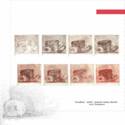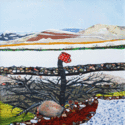
Admira Bradarić
Admira Bradaric -------- www.admira.ba --------
artist about his work, graphic art ------------------------------------------------------------Here and Now------------------------------------------------
Introduction------------------------------------------------
My graphics are emotional interpretations related to the story from the past and so close to disease. Story in the memory. Story from one part of my youth, when I have learned so much.--------------------------------------------
Story-------------------------------------------------------
One experience, that is in the past but also in the future. Now I explain my struggle with myself. My feelings for me and the feelings for other people. The fight with our unconsciousness - my consciousness.-------------------------
Explanation---------------------------------------
Dream, fight and be happy.--------------------------
Kaleidoscopic mirror against / for art-------------------
I wanted with this graphic work - of imaginary pictures to revive the memory. My graphics are intimate experiences from life where pain, goodness and happiness mingle.----------------------------
My colors are: PINK as HEALTH, BLACK as DEATH, RED as LOVE, PURPLE such as TENDERNESS, WHITE as PURITY, BLUE as DREAMS.-------------------------------------------
With these works without walls …---------------------
My depth is in my mirror.------------------------
My voice is a photo, my word is the graphics. That is my poetry.------------------------------------------------------------------------------------------------------------------
the other, on the works of artists, graphic art--------------------------------------------------------."From Introspection to Expression"-------------------------
The graphic series of Admire Bradarić, rarely seen with straightness, demonstrates an artistic act and an artistic expression as a self-referential experience. The author, thereby - in a straightforward, strong and consolidated graphical language - articulates the artistic sublimation of personal experience, a kind of a spiritual, emotional and mental life odyssey of the existential challenge or, so to say, the border situations in which opposing energies overlap: the energy of life which confirms itself: the energy of life which needs to be present in the plentitude of its spiritual and physical composition, in the plentitude of its capabilities - and the energy of dissolution, the transience which represents some kind of existential constant or existential universality. That universality, through the prism of her own experience - Admira Bradarić revolves, experientially processes, regains consciousness, and leads to words in her artistic/graphic declaration, into her intimate graphic diary, which (on one hand) arises from the silence of soliloquies and self-facing but as an artistic visualization in the graphic language; it disaffects, objectifies, shows and publishes - announcing itself to the Other, overcoming loneliness of solipsism and transforming itself into the inter-subjective addressed declaration about life as a struggle and life as a force that confirms its reason and its plentitude.
On the motivational basis and due to such experience, Admira Bradarić chooses the language of graphics as her most suitable mean of expression whose capacity she uses to tell the a story of existence, respectively, using graphic means to stage the dramaturgy of body and soul. In that sense, the author plays a double role: as a direct actor of her own life experience, as an autobiographical observer, and (at the same time) as an artistic entity which transformed the self-reflection into a work of art, into a graphic story and into a strong expressive art event.
Indeed, in the field of artistic/graphic embodiment of experience (which takes place on the stage of body and soul), Admira Bradarić necessarily deals with the demanding task of finding the most appropriate visual means, i.e. with the assignment to find balance between the topical content of her intimate diary and the graphic means which, pure and expressively, can optimize her proposed intention.
In that sense, the narrative content of the confessions of Admira Bradarić from her graphic series gets its pictorial/visual/graphical representation which - as an artistic substance and its specific authoring articulation - gains the attention exactly through the understanding of the author's experience and through measurement of such experience and its visual/graphical embodiment. The medium of sublimation from that experience is the language of graphics itself, but the observer is exposed to two energy impacts: the impact of the author's life experience and his sovereign awakening and the impact of his artistic expression. And that experience (which is the subject of narration) and his artistic articulation - merge into a unique artistic event that (as such artistic event) preserved and strongly expressed the tension and the dramaturgy of that experience which takes place on the stage of body and spirit. In this regard, the graphical sheets of Admire Bradarić are life pageants on the stage, in the matter of the body but also in the medium of the spirit, its inner strength, as well as in the medium of emotions, hope and faith in life. If we focus on the plan of means and techniques which Admira Bradarić uses to write her graphical story, we notice that the author (just for the sake of complexity and stratification of her experience) chooses those graphic techniques and resources which allowed her to mark and dramatize such multi-layering, and to come out with the internal electricity experience, to visualize them, and thereby, very precisely forming stable semantics of her artistic language. Her works have been brought out from a combination of technical methods (print, carving, engraving) - obviously from the conscious intention to find exactly layered, different means of expression for the inner experience - for which she finds the solution right from a combination of techniques which produce different, shaded, expressive results, but ( these techniques and results) seem synergetic and complementarily. The combined use of prints and carving, for example, actually offers two expressive intonations: soft, background print valeres which intone internal, basic mental vibrations and general spiritual and emotional atmosphere, and the sharp intonation of expressively powerful, simplified but detailed carving lines and the emphasized effect of their dynamics within the first plan. It can be said that the author effectively uses a method of technical contrasting and tries out the possibility symbiosis of diverse techniques - of course, with expressive intentions and effects being in repeals of: soft and sharp, light and dark, plastic and solid, resilient and melancholic .... In a similar dramatization role of scenery and basic theme, Admira Bradarić optimizes the effects of drawing means (for example, engraving sheets) and linear structures and their intertwining which interconnects, structures and incorporates the respective surface - by that emphasizing the internal tension of events and experiences. By using these tools and techniques, the author demonstrates its technical competence, thus never forgetting its basic narrative intention: to give a life-experienced testimony, a testimony that is not emotionally deprived, a testimony that addresses man and humanity, which always remembers and never forgets on the stage of body and spirit. With strong expressive will, Admira Bradarić searches and finds those artistic means that (respecting the requirements of technical disciplines) best serve its intention and its emotion: a colorful register following the set goal and the author's expressive need, using few strong, dramatized, colored contrasts or accent on the shape of colored stains in the respective scene (for example, red). The author's existential dramaturgy of body, soul and spirit - however, is not drowned in the gray areas of pain. On the contrary, her speech and her graphic sheets emanate hope and faith into the warmth and even brightness of the resistance to forces of destruction and pain - hope is symbolized also by the paraphrase of the extended language (variations but not the subject "Denture"), and also as the warmth of human intimacy and gratitude is symbolized by a green plant in a red potter - like a tree of life to which the author's artistic being intercedes.-------------------------------------------------
Sulejman Bosto -----
(Faculty of Philosophy in Sarajevo)




























































